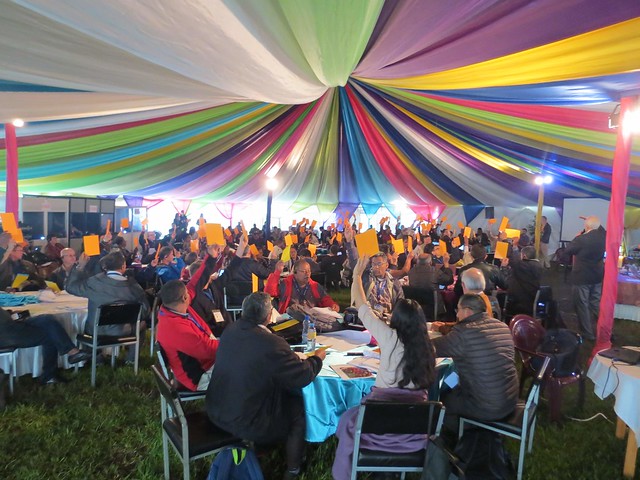Have you ever made a decision when you were for the idea and the other person was against it? Or, been on a board when a vote went five in favour and four against? It’s not fun to move ahead that way, is it? Which of us, if we think of relationships rather than about winning, is OK with “majority rules” decision making? I hope not many.
There must be a better way.
Well, perhaps there is.
In April 2018, I joined Steve Berg and David Wiebe as representatives of the Canadian Mennonite Brethren family at the Mennonite World Conference (MWC) General Council meetings in Kenya. There, we encountered another way to make decisions.
Building consensus
Previously, I was not sure how to do consensus decision making with a board, a congregation, or a delegation.
Here is how it works for MWC.
There are three steps.
- First, is the information stage, which has two parts.
Initially, the focus is on presenting background information on the proposal, the range of possible perspectives, and a course of action. Next, delegates ask questions, seek further explanation, and request additional information.
- The second stage involves deliberation as delegates share viewpoints and discuss differing opinions.
As the conversation moves forward, the facilitator can ask delegates to show their level of agreement by raising one of three coloured cards. Orange represents full agreement. Yellow indicates some agreement with some hesitation. Blue shows disagreement or opposition.
The chairperson can call for raised cards to check whether the body is nearing consensus when making summary statements or when minor modifications to the proposal are offered. If needed, the chair encourages more discussion of the proposal.
- The third step is the decision stage. But it isn’t a quick yea or nay vote. The delegates can speak to the benefits or disadvantages. They are encouraged to indicate with their cards their level of agreement.
In my experience at MWC, those who had not raised orange cards were afforded opportunities to share lingering concerns, objections, or additional perspectives. This gave assurances that each person and their view was important, and that the decision was being made by the group.
When the chair believes a consensus has been reached, he or she asks for a show of cards. If the colours are all affirmative, consensus can be declared, and the proposal is accepted.
However, if consensus is not reached, further discussion can continue to address concerns or answer questions. More questions can determine the level of support, including “Who doesn’t support the proposal as their first option, but is prepared to accept it?” and “Who is not prepared to accept the proposal?”
Agreement without unanimity
Those who oppose the proposal are invited to share their misgivings. If consensus still cannot be reached, they are asked if they feel they have been heard. The larger body is asked if they feel those who dissent have heard the other side.
As I reflect on my time in these meetings, it was these acts of ensuring mutual listening and understanding that allowed us to move ahead as a group, instead of being divided into factions.
In this way, a group can reach agreement even without unanimity.
Or, the group may postpone the final outcome to the next meeting.
Or, if a decision must be made at once, a conventional vote decided by formal majority would be taken.
We likely can’t redo votes of the past. But as we face decisions, let’s consider this model to help maintain the unity of the Spirit among us. It will help us learn from each other and even deepen our relationships. We’ll find that it feels good to move forward together!
Laurence Hiebert
is pastor at Mountainview Grace Church, Calgary.
This article is based on “Making Decisions by Consensus Guidelines” (MWC Reference Notebook) and my own experience of participating in this consensus model as a delegate representing the Canadian Conference of MB Churches at the Mennonite World Conference General Council meetings at Limuru, Kenya, in 2018.
Updated June 24, 2019: typo corrected.
